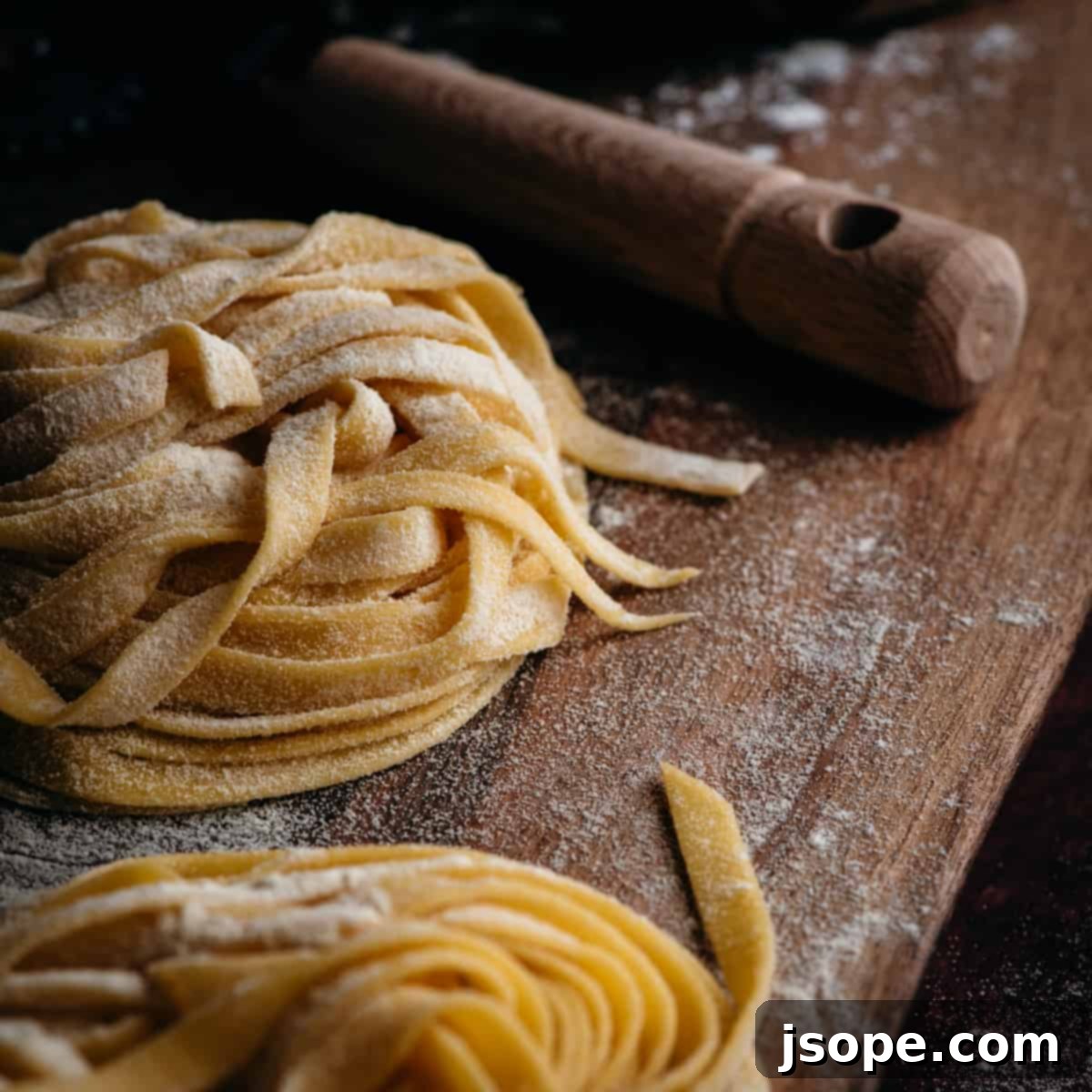There’s nothing quite like the taste and texture of fresh homemade pasta. It’s an experience that transcends mere cooking, transforming your kitchen into a vibrant Italian trattoria and inviting friends and family to partake in a culinary journey. Far from being an intimidating task, making pasta from scratch is surprisingly straightforward, incredibly rewarding, and an absolute joy for everyone involved. Forget the store-bought varieties; once you master the art of homemade pasta, you’ll never look back. This ultimate guide will walk you through everything you need to know, from selecting the right ingredients and essential equipment to crafting versatile doughs and shaping them into your favorite forms. Get ready to elevate your home cooking and savor the unparalleled flavor of truly fresh pasta!
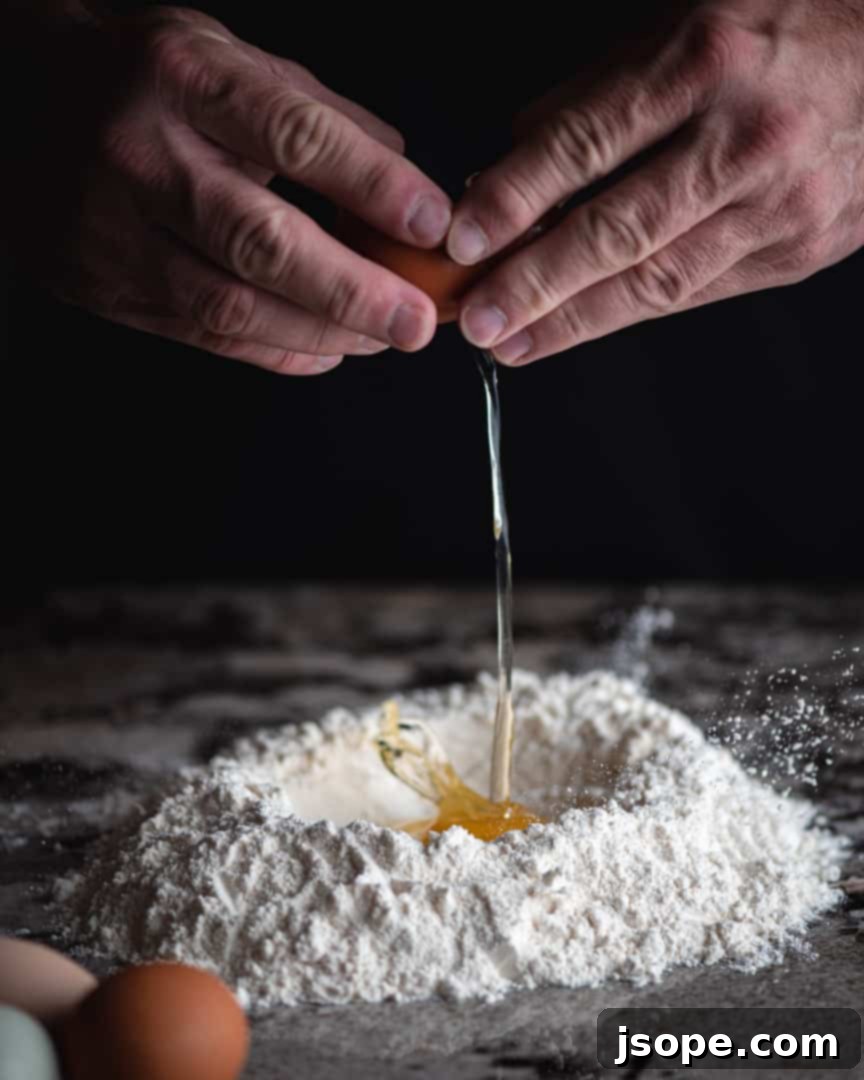
Table of Contents
- Essential Pasta Making Equipment
- Choosing the Right Flour for Perfect Pasta
- Our Signature Multipurpose Pasta Dough Recipe
- Delicious Recipes Using Our Versatile Pasta Dough
- Pasta Cutting and Shaping Guide
- Perfect Sauces for Your Homemade Pasta
- Explore More Delicious Italian Dishes
- Homemade Pasta FAQ
- Full Homemade Pasta Dough Recipe Card
Essential Pasta Making Equipment
While the romantic notion of making pasta entirely by hand, relying solely on your skill and a trusty rolling pin, is certainly achievable, investing in a few key pieces of equipment can significantly streamline the process and lead to more consistent, professional-looking results. For the beginner, your hands for mixing, a strong rolling pin, and a sharp knife are truly all you *need*. However, if you’re serious about bringing the authentic Italian pasta-making experience into your home, consider these invaluable tools:
The Game-Changer: Pasta Rollers and Cutters
If you’re already the proud owner of a KitchenAid Stand Mixer, then acquiring the dedicated pasta roller attachments is an absolute must. These attachments transform your mixer into a pasta-making powerhouse, allowing you to effortlessly roll dough to various thicknesses and cut it into perfect strands of fettuccine or spaghetti. The consistent thickness achieved with a machine is crucial for even cooking and a delightful texture, ensuring every bite is perfectly al dente. This investment pays dividends in convenience and superior, restaurant-quality results, especially if you plan to make pasta regularly.
Budget-Friendly Alternatives for Aspiring Pasta Makers
Not everyone is ready to invest in high-end mixer attachments, and that’s perfectly fine! There are excellent, more budget-friendly options that will still significantly enhance your pasta-making journey, making the process accessible to everyone:
- Hand-Crank Pasta Roller: A classic choice, the hand-crank pasta roller is a traditional and highly effective tool. It allows you to feed your dough through a series of rollers, gradually thinning it down to your desired gauge. Many models also include built-in cutters for spaghetti and fettuccine, offering great versatility at an accessible price point. While it requires a bit of manual effort and a sturdy surface to clamp onto, it provides a tactile connection to the process that many home cooks cherish, truly immersing you in the craft of pasta making.
- Adjustable Pastry Cutter: For those who prefer hand-cutting or want to create specific shapes like pappardelle, lasagna sheets, or even unique decorative edges, an adjustable 5-wheel pastry cutter is a fantastic, inexpensive addition. It ensures uniform strips and clean cuts, making your pasta look as good as it tastes, adding a professional touch without the high cost.
- Large Pot: An often-overlooked but absolutely essential piece of equipment. A spacious pot allows the pasta to move freely in plenty of salted boiling water, preventing sticking and ensuring an even cook. For fresh pasta, which cooks very quickly, having ample space is key to achieving that perfect tender-chewy bite.
No matter your budget or existing kitchen arsenal, there’s a way to enjoy the wonders of homemade pasta. The right tools simply make the journey smoother, more enjoyable, and the results more consistently delicious.
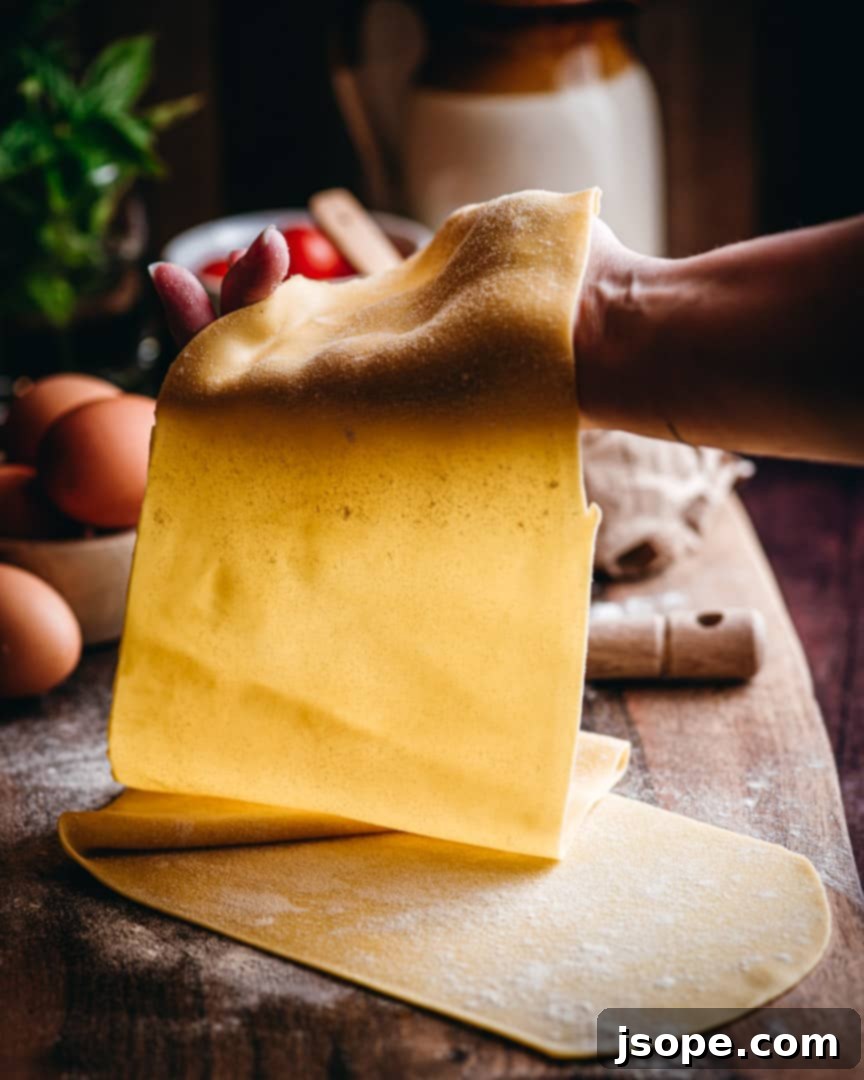
What Flour Should I Use for Homemade Pasta?
The type of flour you choose plays a pivotal role in the texture and mouthfeel of your homemade pasta. While many flours can be used, one stands out as the gold standard for creating that authentic Italian pasta experience:
Tipo 00 Flour: The Gold Standard for Authentic Italian Pasta
For an authentically silky, smooth, and delicate pasta that melts in your mouth, Tipo 00 flour is unequivocally the best choice. This specialized Italian flour is milled much finer than standard all-purpose flour, resulting in a super-fine texture. It also boasts a specific protein content that is ideal for pasta; lower than bread flour but sufficient to develop just enough gluten for elasticity without making the pasta tough or overly chewy. When cooked, pasta made with Tipo 00 flour boasts an exquisite texture that absorbs sauce beautifully and provides a truly sublime dining experience.
Accessible Alternatives: Bread Flour and All-Purpose Flour
Don’t despair if Tipo 00 flour isn’t readily available in your local grocery store or if you prefer to work with what you have on hand. You can absolutely make delicious and satisfying pasta using other common flours:
- Bread Flour: With its higher protein content, bread flour develops more gluten, which will yield a pasta with a firmer, more substantial bite. It’s an excellent option if you enjoy a chewier pasta texture, similar to some rustic, regional Italian varieties. This flour is particularly forgiving for beginners as its robust gluten structure makes the dough easier to handle without tearing.
- All-Purpose Flour: A universally accessible option, all-purpose flour can certainly be used for homemade pasta. We’ve conducted side-by-side comparisons of Tipo 00 and all-purpose flour and found no noticeable difference in flavor or the required ingredient ratios for the dough. However, you might notice that pasta made with all-purpose flour benefits from a slightly longer cooking time—about 30 seconds to 1 minute extra—to achieve optimal tenderness. The texture will be slightly less silky than with Tipo 00, but still wonderfully fresh, elastic, and far superior to most dried pasta varieties.
Ultimately, the best flour is the one you have and enjoy working with. Experiment to find your personal preference, but for that truly authentic, melt-in-your-mouth experience, Tipo 00 remains our top recommendation.
Our Signature Multipurpose Pasta Dough Recipe
Our journey into homemade pasta began several years ago during our first unforgettable trip to Italy. Inspired by the culinary traditions, the vibrant markets, and the sheer delight of fresh pasta, we returned home determined to recreate that magic in our own kitchen. After countless experiments and refinements, blending traditional techniques with a touch of personal flair, we finally perfected our Multipurpose Pasta Dough recipe – a true winner that has become our weekly go-to. This dough is incredibly versatile, serving as the perfect foundation for an extensive range of pasta dishes, from layered lasagnas and delicate fettuccine to intricate stuffed pastas like ravioli and tortellini.
What Makes Our Dough Special? A Unique Blend for Silky Perfection
Unlike some heavier egg pasta recipes that rely on an abundance of egg yolks for richness, our recipe strikes a beautiful balance. We incorporate a thoughtful blend of whole eggs and extra egg yolks for essential structure, a vibrant golden color, and a wonderfully rich flavor. But what truly sets this dough apart, creating its signature silky texture and delightful mouthfeel, is the intentional addition of milk and melted unsalted butter. While not the most traditional Italian approach, these ingredients contribute to an unparalleled tenderness and a subtle richness that we absolutely adore. The butter adds a luxurious depth of flavor and helps create a tender, pliable dough that’s a dream to work with, while the milk ensures a beautifully smooth consistency.
Prepare Ahead: Freeze for Future Feasts!
One of the fantastic advantages of this particular dough is how wonderfully it freezes. Once you’ve rolled and cut your pasta into your desired shapes – whether it’s long strands of fettuccine, delicate ravioli, or robust lasagna sheets – you can easily freeze it for later use. This means you can always have a stash of fresh pasta on hand, ready to be cooked in a pinch, making weeknight dinners or impromptu gatherings effortlessly delicious and remarkably convenient. Imagine having homemade pasta whenever the craving strikes, without the immediate effort of making the dough from scratch every time!
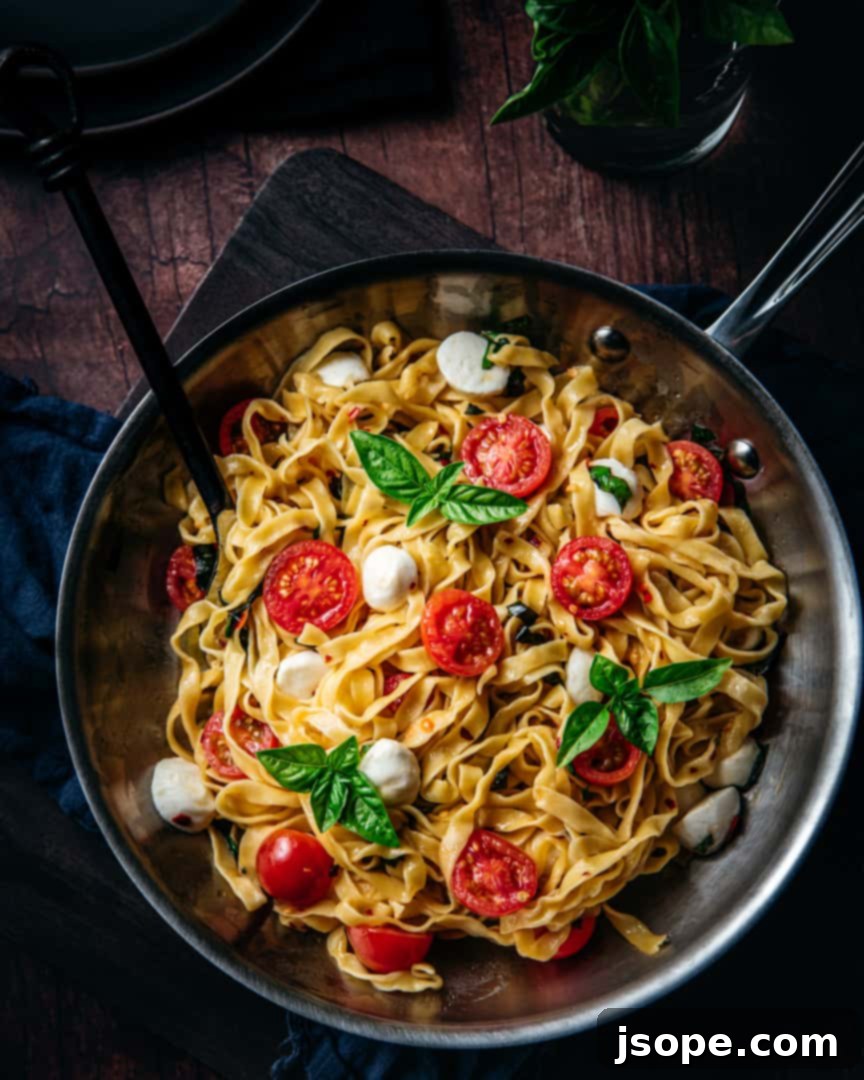
Delicious Recipes Using Our Versatile Pasta Dough
Our multipurpose pasta dough is a canvas for endless culinary creativity, allowing you to craft a wide array of Italian classics right in your home kitchen. Here are some of our absolute favorite recipes that showcase the incredible versatility and deliciousness of this homemade foundation:
Tagliatelle with Mushroom Sausage Cream Sauce
This hearty and comforting dish is a match made in heaven for freshly cut tagliatelle. The wide, flat ribbons of pasta are ideal for clinging to a rich, savory cream sauce brimming with earthy mushrooms and robust Italian sausage. Best of all, tagliatelle can be easily cut by hand with just a knife, making this a perfect recipe even if you don’t have a pasta machine for cutting – a truly rustic and satisfying meal.
Summer Pasta (Pasta D’Estate)
When the days are long and warm, and you crave a light yet incredibly flavorful meal, our Summer Pasta is the perfect answer. This super easy and fresh dish comes together quickly, utilizing seasonal produce to create a vibrant experience that’s perfect for those hot days when spending hours in the kitchen is simply not an option. The tender homemade pasta truly elevates the fresh, bright flavors of summer ingredients.
Chicken Piccata with Caper Lemon Butter Sauce
We believe the best way to enjoy a classic Chicken Piccata is alongside a generous serving of homemade spaghetti or fettuccine. The fresh pasta’s tender texture and porous surface are absolutely perfect for soaking up every last drop of that bright, tangy, and utterly delicious Caper Lemon Butter Sauce. The delicate flavors of lemon and caper are beautifully balanced by the richness of the butter, creating a symphony of flavors and textures that is both comforting and sophisticated.
Pumpkin Ravioli with Parmesan Sage Cream Sauce
As the leaves begin to turn and a crispness fills the air, our Pumpkin Ravioli becomes an irresistible delight. The sweet, earthy pumpkin filling nestled within tender homemade pasta squares, all bathed in a luxurious Parmesan Sage Cream Sauce, is the epitome of autumnal comfort and elegance. This delightful cream sauce, however, is so versatile and universally loved that we find ourselves making it year-round to complement a variety of pasta shapes, proving its timeless appeal!
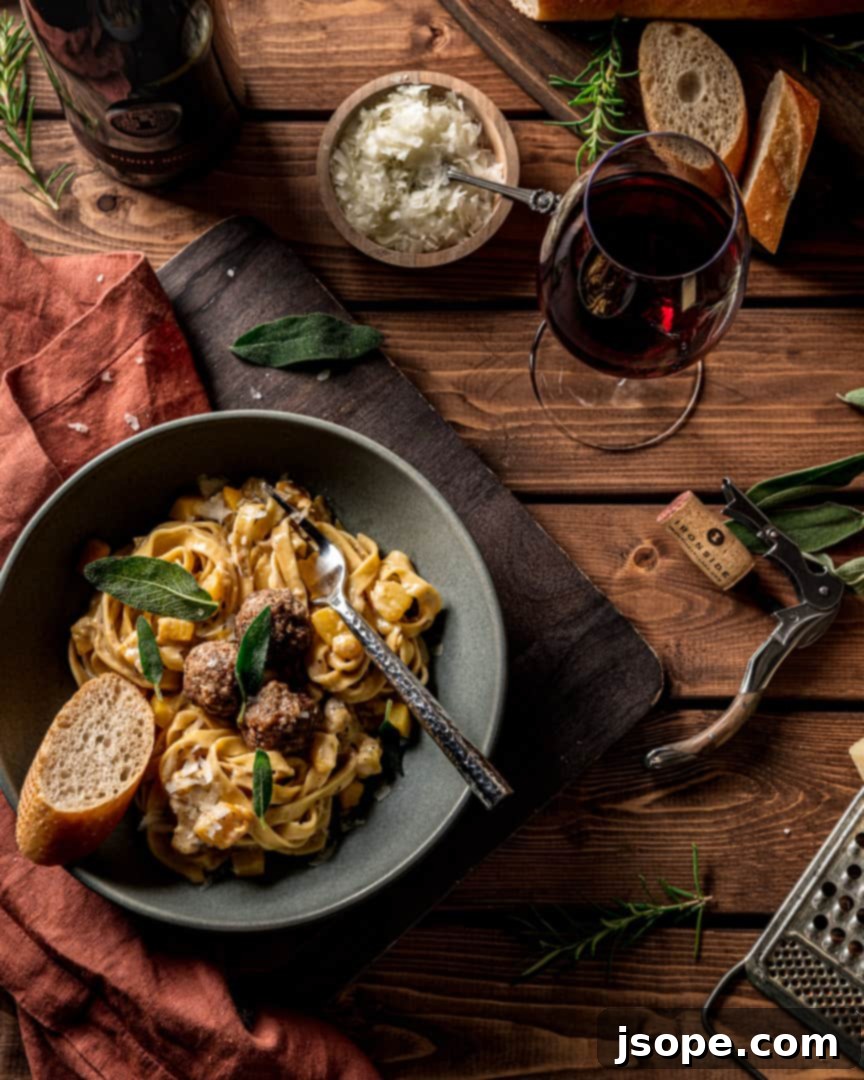
Fettuccine with Winter Spiced Cream Sauce and Rosemary Sage Meatballs
Fettuccine is arguably the most frequently made pasta cut in our household, and for good reason. Its broad, flat shape is ideal for rich, substantial sauces that cling beautifully to each strand. It provides the perfect vehicle for our warm and inviting Winter Spiced Cream Sauce, which is wonderfully complemented by tender, aromatic Rosemary Sage Meatballs. This dish is pure comfort in a bowl, especially on a chilly evening, offering a deeply satisfying and flavorful experience.
Roasted Zucchini and Tomato Pasta
Simple yet bursting with exquisite flavor, this Roasted Zucchini and Tomato Pasta is a vibrant celebration of seasonal produce. It’s particularly fantastic in the summer months when zucchini and tomatoes are at their peak freshness and sweetness. The roasting process intensifies their natural sugars, creating a naturally flavorful and light sauce that beautifully coats every strand of your homemade pasta, proving that sometimes, the simplest ingredients, when fresh, yield the most spectacular results.
Pasta Cutting and Shapes: A Creative Journey
Once you’ve mastered the art of rolling your pasta dough to the perfect thickness, the next exciting step is shaping it into various forms. Each pasta shape has its own unique charm and is designed to perfectly complement different sauces and dishes, enhancing the overall dining experience. This guide will help you transform your smooth pasta sheets into classic Italian shapes, bringing variety and authenticity to your homemade meals.
Lasagna Sheets
For classic lasagna, which requires broad, flat layers, simply leave your rolled pasta sheets whole. You’ll then cut them to the precise length of your baking dish and trim the width as needed to fit perfectly, ensuring an even and delicious layer in your lasagna casserole. The fresh, tender sheets absorb the rich sauce beautifully, making for an unforgettable dish.
Cannelloni
To prepare your pasta for cannelloni, which are large, tube-shaped pasta traditionally stuffed and baked, cut your rolled sheets into rectangles, typically measuring approximately 5 x 4 inches (about 12 x 10 cm). Lay these cannelloni rectangles flat, then place about 3-4 tablespoons (or 75g) of your chosen filling along the center. Carefully roll the long ends together, overlapping by about ½ inch (1-2 cm) to create a sealed tube. If desired, add extra filling to the ends to ensure the cannelloni is completely packed before baking, ensuring a rich bite every time.
Spaghetti
While traditional spaghetti is cylindrical and often made by extruding pasta dough through a die, you can easily create a similar, delicious version by hand or with a cutter attachment on your pasta machine. For handmade “spaghetti,” take your pasta sheets and cut them into very thin strips, approximately ⅛ inch (1-2mm) wide. This essentially creates a finer cut of fettuccine, perfect for lighter, oil-based sauces, pesto, or delicate seafood preparations.
Fettuccine
Fettuccine, meaning “little ribbons” in Italian, is a popular flat pasta cut, slightly wider than spaghetti. To make fettuccine, take your pasta sheets and cut them into strips approximately ¼ inch (6-7mm) wide. Its broader surface area makes it excellent for capturing rich cream sauces like Alfredo, robust meat ragùs, or hearty tomato-based sauces, ensuring every strand is coated with flavor.
Pappardelle
Even wider and more substantial than fettuccine, pappardelle (“to gobble up”) are broad, flat noodles originating from the Tuscany region of Italy. For pappardelle, cut your pasta sheets into generous strips, roughly 1 inch (25 mm) wide. These substantial ribbons are perfect for hearty, slow-cooked meat sauces, wild boar ragù, or rich mushroom sauces, allowing the pasta to stand up to bold and robust flavors.
Ravioli
Making ravioli is a delightful process of creating tender, filled pasta pockets. Start by cutting your pasta sheets into precise 3 x 3 inch (7 x 7 cm) squares. Place about 1-2 teaspoons of your desired filling in the center of one square. Dip your finger in water and moisten all four edges of the square; this creates a seal. Carefully place a second pasta square directly on top, aligning the edges. Gently press down around the filling, working your way outwards to seal the edges completely, taking care to push out any trapped air around the filling. For a decorative and secure seal, crimp the edges with a fork or use a dedicated ravioli cutter. Place the finished ravioli on a parchment paper-lined sheet tray dusted with flour or semolina to prevent sticking.
Other Exciting Pasta Shapes
The world of pasta shapes is vast and wonderful, offering endless opportunities for culinary exploration! Beyond these classics, our blog features even more intricate and unique forms, often accompanied by helpful tutorials and videos on shaping. Don’t miss exploring some of these exquisite options:
- Agnolotti del Plin: These small, pinched pasta parcels originate from Piedmont and are often filled with savory roasted meats or vegetables, typically served with simple butter and sage sauce.
- Tortellini: Small, ring-shaped pasta, traditionally filled with meat, cheese, or vegetables, and famously served in a rich broth, especially during holidays.
- Tagliatelle: (Already described above, but linking here for easy access alongside other shapes and specific recipes.)
Perfect Sauces for Your Homemade Pasta
Now that you’ve mastered the art of making fresh pasta, it’s time to pair it with a sauce that truly lets its quality shine. Homemade pasta, with its delicate texture and rich flavor, deserves a sauce that complements and enhances it, rather than overpowering it. Here are some of our top recommendations, ranging from rich meat ragùs to vibrant, fresh options, ensuring there’s a perfect match for every mood and season:
- Pork and Shiitake Mushroom Ragù: A deeply savory and slow-cooked ragù, perfect for wide, hearty pasta shapes like pappardelle or tagliatelle. The combination of tender pork and earthy shiitake mushrooms creates an umami depth that is simply irresistible and incredibly comforting.
- Marinara Sauce from Scratch: The quintessential pasta sauce. Our homemade marinara is bright, fresh, and bursting with the sweet-tangy flavor of ripe tomatoes and aromatic herbs. It’s a versatile sauce that pairs beautifully with almost any pasta shape, from classic spaghetti to sturdy penne, a true staple for any pasta lover.
- Lobster Ravioli with Lemon Cream Sauce: An elegant and indulgent choice for a special occasion. This delicate and bright lemon cream sauce perfectly highlights the sweetness of lobster, making it an ideal companion for delicate filled pastas like ravioli or tortellini, creating a luxurious and memorable dish.
- The Best Homemade Shrimp Scampi: A quick, flavorful, and incredibly satisfying dish that comes together effortlessly. The vibrant garlic, rich butter, and crisp white wine sauce is heavenly with thin pastas like spaghetti or linguine, allowing the tender, succulent shrimp to be the undeniable star of the plate.
- Crunchy Chicken with White Wine Lemon Butter Sauce: While featuring chicken as a main component, the accompanying sauce is divine over a bed of fresh fettuccine or spaghetti. The zesty lemon and rich butter create a light yet satisfying complement to your homemade pasta, soaking into every strand for a burst of flavor.
- Homemade Italian Pizza Sauce: Although typically crafted for pizza, this vibrant, herb-infused sauce can be thinned slightly with a bit of pasta water and tossed with your homemade pasta for a simple, rustic meal, especially when you’re craving those comforting, classic Italian flavors in a hurry.
Looking for More Delicious Italian Dishes?
If your passion for Italian cuisine extends beyond the marvelous world of pasta, you’re in for an absolute treat! In 2021, we embarked on a monumental project: writing our very first cookbook, a labor of love titled Mangiamo!
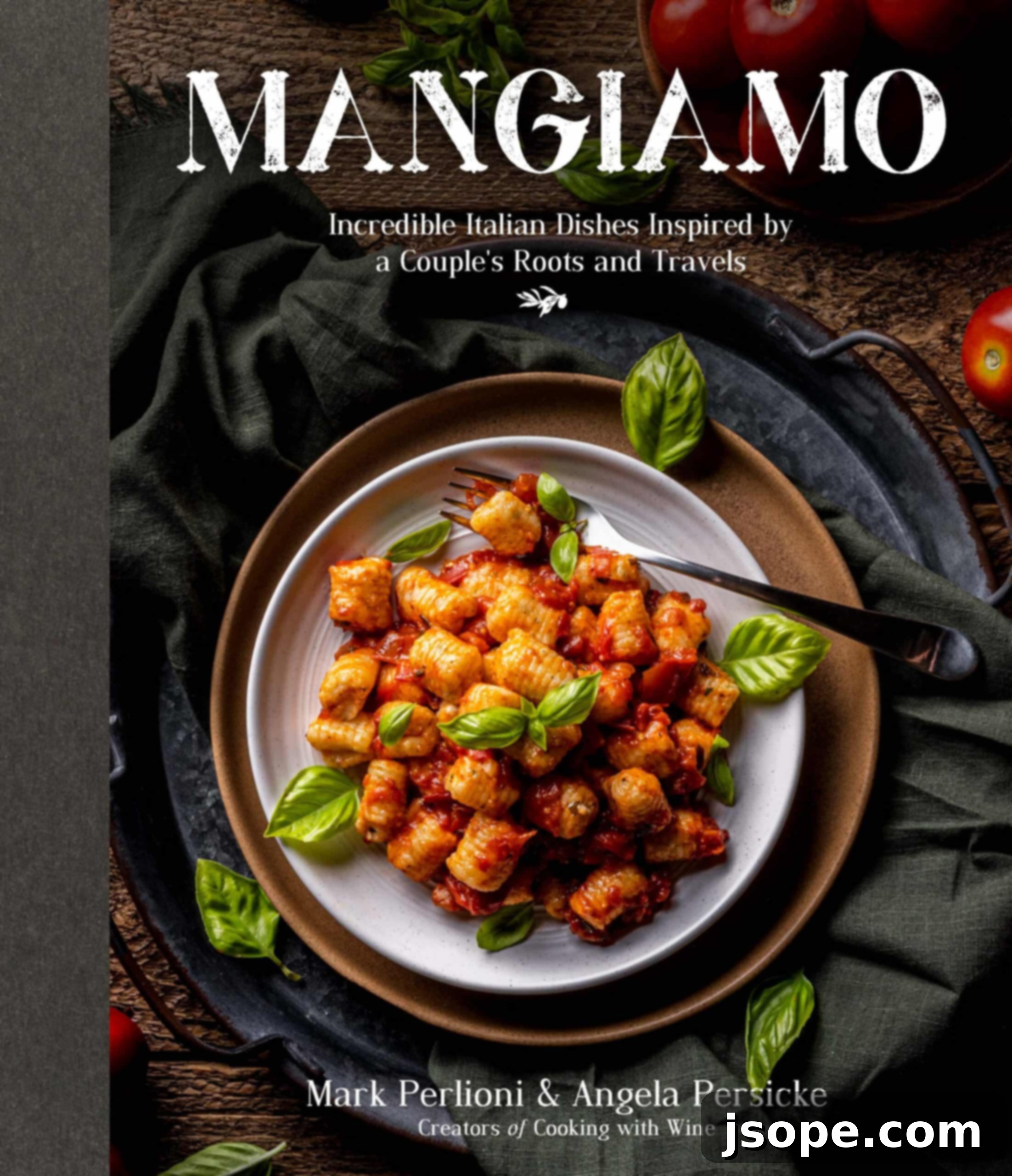
Mangiamo is more than just a cookbook; it’s a heartfelt celebration of Italian home cooking, featuring 60 meticulously crafted recipes designed to bring the warmth and flavors of Italy into your kitchen. Within its pages, you’ll find an expansive array of pasta dishes, including various preparations of spaghetti, cavatelli, lasagna, and cannelloni, alongside delightful potato, ricotta, and sweet potato gnocchi varieties. But it doesn’t stop there! We’ve also included some of our most cherished meat and seafood dishes, delectable appetizers and small bites perfect for entertaining, and a delightful selection of desserts and cocktails to complete any Italian feast. It truly encapsulates everything we love about Italian culinary traditions, all bundled into one beautiful, easy-to-follow package!
To learn more about Mangiamo and get your copy, whether for yourself or as a gift for the Italian food lover in your life, visit our dedicated page HERE.
Enhance Your Kitchen: Visit Our Amazon Storefront for Favorite Essentials
Equip your kitchen with the best tools to make your culinary adventures even more enjoyable and efficient. Explore our carefully curated selection of favorite kitchen essentials and recommended gadgets on our Amazon Storefront. From stand mixer attachments to the perfect rolling pins, we’ve hand-picked items that we use and love in our own kitchen to help you master homemade cooking.
Homemade Pasta FAQ
Fresh pasta dough is highly perishable and is best used within 24 hours of preparation. For optimal flavor, texture, and color, we strongly recommend making and using the dough on the same day you prepare it. While it can be stored tightly wrapped in plastic in an airtight container in the fridge for up to a day, you may notice subtle changes in its quality, becoming slightly less pliable or vibrant. Always aim for same-day use for the freshest, most delightful results.
Absolutely! While Tipo “00” flour, a finely milled soft wheat flour, is considered the benchmark for achieving a perfectly smooth and silky pasta texture, regular all-purpose flour can certainly be used to make delicious homemade pasta. The result will still be wonderfully fresh and flavorful, though it might yield a slightly chewier pasta compared to one made with Tipo 00. If using all-purpose flour, you might find that it benefits from a slightly longer cooking time (around 30-60 seconds extra) to achieve optimal tenderness.
Not necessarily! Many traditional pasta recipes, especially from the southern regions of Italy, famously use only two simple ingredients: durum wheat semola flour and water. These eggless doughs create a firm, rustic, and chewy pasta. However, the versatile dough we provide in this recipe, common in northern Italian cuisine, does use eggs. Egg pasta dough is known for its richer flavor, much silkier texture, and denser consistency, making it a luxurious choice for many dishes and offering a distinct culinary experience.
For best results, consume freshly shaped pasta on the same day it’s made. If you plan to use it within 24 hours, dust it lightly with semolina flour and store it in an airtight container in the refrigerator to prevent it from drying out or sticking. For longer storage, freezing is the most effective method. To freeze uncooked pasta, arrange your freshly cut pasta in a single layer on a sheet pan dusted with semolina flour (this prevents sticking). Place the uncovered sheet pan in the freezer for about 30 minutes until the pasta is firm and individual pieces are frozen. Once firm, transfer the pasta to an airtight freezer-safe bag or container. It can be stored for up to 6 months. When ready to cook, simply add the frozen pasta directly to a pot of boiling salted water; there’s no need to thaw. Just add approximately one extra minute to the regular cooking time.
Yes, allowing your freshly made pasta dough to rest is a crucial step for achieving the best texture and workability. After kneading, wrap the dough tightly in plastic wrap (to prevent it from drying out) and let it rest in the fridge for at least 30 minutes (and up to 24 hours). This resting period serves several important purposes: it allows the flour to fully hydrate and absorb the liquid ingredients, and it gives the gluten a chance to relax. The result is a more pliable, elastic, and smooth dough that is much easier to roll out thinly without tearing, leading to a superior and more tender cooked pasta.
📖 Homemade Multipurpose Pasta Dough: The Full Recipe
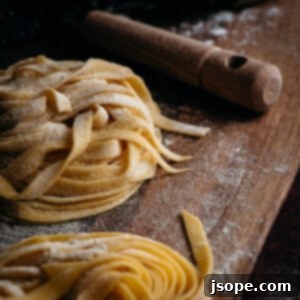
Homemade Multipurpose Pasta Dough
Pin Recipe
Equipment
- 1 Rolling pin, hand crank roller or KitchenAid roller attachment
- 1 Large pot
Ingredients
- 1 ½ cups (200g) Tipo 00 flour + additional ¼ cup (30 g) set aside if needed if dough is overly wet
- 2 teaspoon (12g) melted unsalted butter
- 2 teaspoon (10g) whole milk
- 1 large (57g) whole egg
- 3 large (45g) egg yolks
Instructions
Make the Dough
- Pile flour on a clean flat surface. In the center of the pile, make a well with your fingers all the way to the bottom, leaving a strong wall of flour as a barrier around the outside. Next, carefully add the melted butter, milk, whole egg, and egg yolks to the center of the well.
- With a fork, gently beat the egg mixture, slowly incorporating the flour from the inside edges of the well. Use a bench scraper to assist this process by carefully pushing and folding the flour into the center. Once the egg mixture begins to form a sticky mass and is no longer runny, continue to use your bench scraper to fold the remaining flour into the dough until you are able to bring the dough together by hand. It will be very sticky at this point.
- Transfer the sticky mass to a lightly floured surface. Knead the dough by hand using the heel of your hand to push down into the flat surface of the table, then folding the dough onto itself and rotating it a quarter turn. Repeat this motion until the dough forms a smooth, elastic ball. This should take about 5 minutes of consistent kneading.
- At this point, your dough should have a smooth, almost leather-like feeling, not dry and flaky, nor overly sticky. You may need to adjust the consistency: if it feels dry, wet the tips of 1-2 fingers with water and continue to knead, repeating as needed. If your dough appears too wet, add a pinch of the reserved ¼ cup flour at a time, and knead again, repeating until the desired texture is achieved.
- Once the dough is ready, gently press it into a disc approximately 2 inches (5 cm) thick and wrap it tightly in plastic wrap to prevent it from drying out. Place it in the fridge for at least 30 minutes, and up to 24 hours, to rest. This crucial step allows the gluten to relax and the flour to fully hydrate.
Roll out the Dough
- Remove the rested pasta dough from the refrigerator and let it sit at room temperature for 10 minutes, still wrapped in plastic. Unwrap, and knead on a lightly floured surface for a few minutes by hand to further warm it and enhance its elasticity.
- Cut the dough into manageable pieces, roughly the size of the palm of your hand (approx 85-100g per piece). Flatten each piece on a flat surface with your hands to about ¼ inch (6 mm) thick. Now, run each piece through a pasta roller (either hand-crank or stand mixer attachment) starting with the widest setting.
- Fold the dough sheet into thirds (like a letter) and run it through the widest setting a total of 3 times. This helps to strengthen the gluten and create a smooth sheet. If the sheet gets too wide, you can fold the sides in to narrow it before passing it through. If it rips or tears, simply fold it over, press it together, and start again on the widest setting. Once smooth, run it through the next setting 2 more times, folding in between.
- Then, run the sheet through once at the next lowest setting, and continue this process, decreasing the setting one notch at a time, until your desired thickness is achieved. We typically leave it slightly thicker for spaghetti and fettuccine and roll it thinner for delicate lasagna, cannelloni, pappardelle, and ravioli. Every pasta roller is different, so you may need to try out a few thicknesses to find what you prefer for your dishes.
- As you roll out each pasta sheet, lay it carefully on a flat surface generously dusted with flour or semolina flour to prevent sticking, while you continue to roll out the rest of the dough.
- Alternatively, if you’re using a rolling pin, be prepared to put some significant muscle into it! You want to roll the sheet out very thinly until you can almost see the light through it when you hold it up. This requires patience and consistent pressure.
- Once all sheets are rolled, cut your pasta into your desired shapes for the dish you’re preparing. Sprinkle and toss the cut pasta lightly with additional semolina flour to prevent the individual pieces from sticking together. Use immediately or freeze (see notes below for freezing instructions).
Cooking Your Fresh Pasta
- To cook fresh pasta, bring a large pot of water to a vigorous rolling boil over high heat. Once boiling, generously season the water with salt (add approximately 2 tablespoons of coarse salt per 6-8 quarts of water; your water should truly taste like the ocean). Add your fresh pasta to the boiling water and stir gently with a wooden spoon or tongs to separate the noodles and prevent them from clumping. Allow the pasta to cook for a very brief 2-3 minutes, or until it reaches your preferred al dente texture (it cooks much faster than dried pasta). Immediately remove the cooked pasta to a colander to drain. Enjoy your perfectly cooked fresh pasta simply with some high-quality extra virgin olive oil and a sprinkle of Parmesan for a quick, tasty meal, or toss it with your preferred sauce.
Video
Notes
If cooking frozen pasta: There’s no need to thaw! Simply remove the pasta directly from the freezer and add it to your vigorously boiling salted water. Add approximately one additional minute to the standard cooking time (usually 3-4 minutes total) to ensure it cooks through to al dente perfection.
Nutrition
Carbohydrates: 36g
Protein: 13g
Fat: 9g
Saturated Fat: 3g
Polyunsaturated Fat: 1g
Monounsaturated Fat: 3g
Trans Fat: 0.1g
Cholesterol: 240mg
Sodium: 105mg
Potassium: 139mg
Fiber: 1g
Sugar: 0.5g
Vitamin A: 405IU
Calcium: 46mg
Iron: 3mg
Tried this recipe?
Let us know how it was! Your feedback is invaluable.
